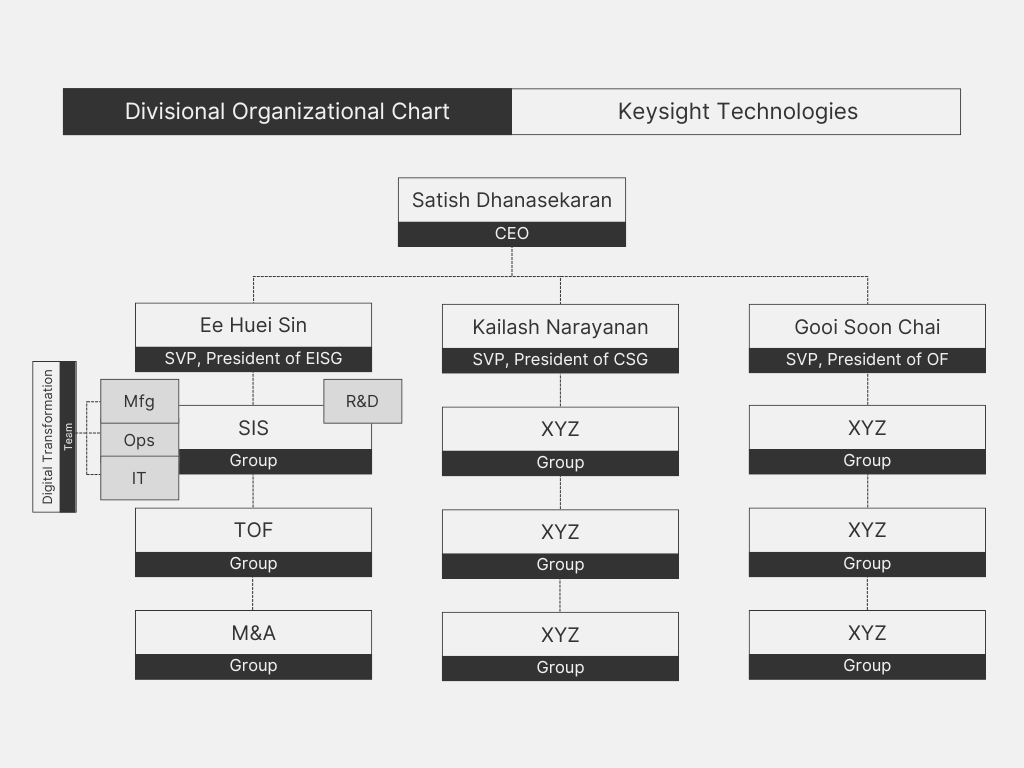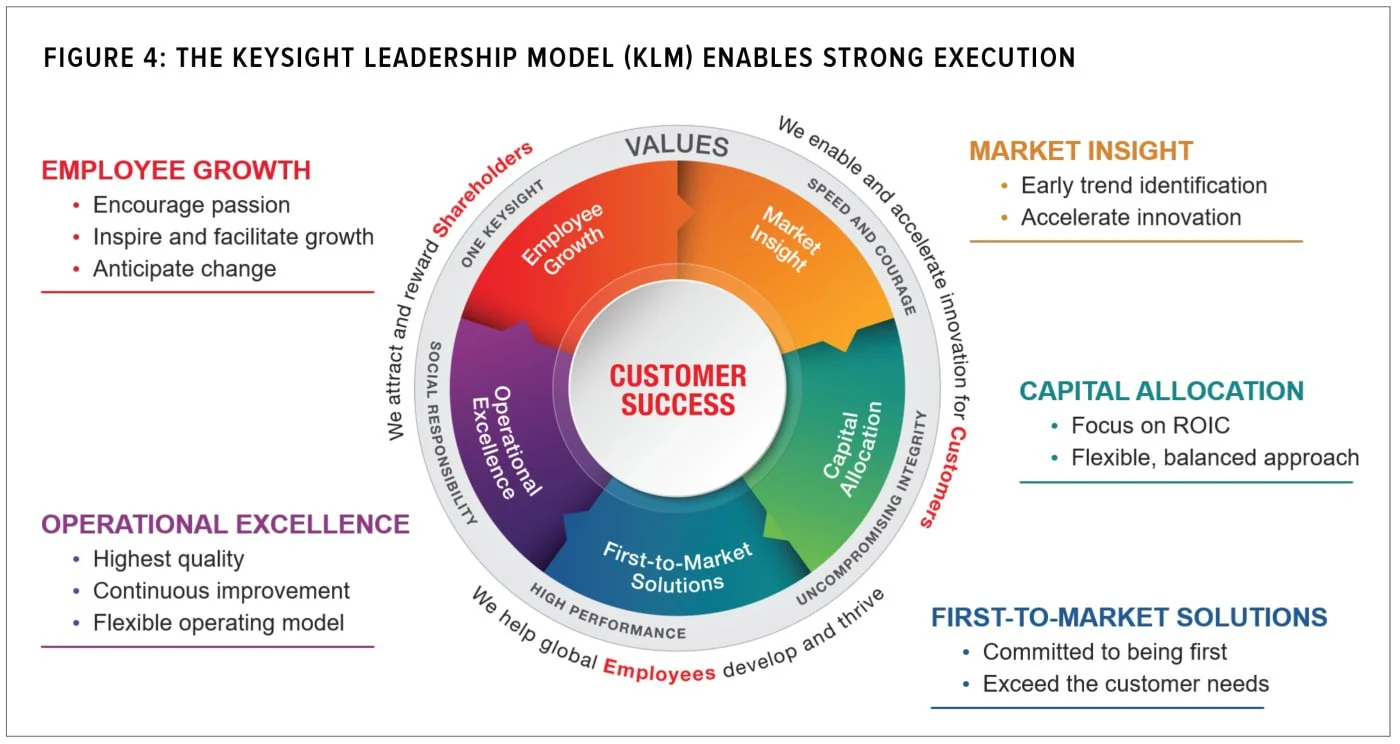Looking Back To Look Ahead
In my Managing People and Organisations class with Professor Pilar Opazo, I wrote an essay reflecting on my work experiences through MIT Sloan's Three Lenses framework. Professor Opazo, who brings a rich academic background from Columbia University and MIT Sloan, focuses her research on organisational behaviour, innovation, and creativity. My essay, which earned the top mark in the cohort, was showcased to the class as a stellar writing example. It explores how these lenses of strategic design, political factors, and cultural behaviour apply to real-world workplace dynamics.
Keysight Technologies, a “grandchild” spin-off company from Hewlett-Packard (HP), retains in its DNA numerous aspects of its original strategic, political, and cultural formula while simultaneously deploying a strategic Divisional Structure under different product lines and markets.
Figure 1. Example Divisional Organisation Chart of Keysight Technologies.
Under the Strategic Design Lens’ divisional organization structure and through the Political Lens’ perspective, power was decentralised as each division had a President as the head. As a result, the divisions under this autonomous leadership were agile when responding to market changes and operated with high clarity and efficiency. Additionally, under the Strategic Design Lens, “leadership support[ed] our strategy to deliver first-to-market solutions for our customers, which in turn enable[ed] them to be first to market with their products and gain a competitive advantage.” This statement is cemented by the company’s heavy investments in its R&D arm, Keysight Laboratories, and its M&A groups aimed at acquiring and integrating different computer networking and software companies, like Ixia and Eggplant, to offer unique and quality product solutions. All of these aspects of Keysight are exemplified by the “HP Way,” now branded as the “Keysight Leadership Model” (KLM), which pioneered the way for a majority of Silicon Valley values. Framed under the Cultural Lens, the KLM highly stressed technical innovation (R&D), power decentralization (divisional structure), and most importantly respect for individuals. The founders emphasized the managerial ideas of “Management By Walking Around” and the “Open-Door Policy,” which resulted in HP and spinoff employees feeling connected to management in an artificially created pseudo-flat structure.
The Keysight Leadership Model (KLM)
The KLM takes heavy inspiration from The HP Way and focuses its values on Employee Growth, Market Insight, Capital Allocation, First-To-Market Solutions, and Operational Excellence.
During my time at Keysight as an Industrial Engineer on the Digital Transformation Team, I reported to the middle managers of the Semiconductor Infrastructure Solutions (SIS) group of the EISG division, but my influence spread across multiple business units (R&D, Mfg, Quality, IT, etc.) within SIS, making our team a Linking Mechanism meant to align different business units and stakeholders with different interests to the overarching digital transformation strategy. I held influence over decisions without the official power of having direct reports, so I needed to constantly request resource alignment within my division on the transformation project. Fortunately, given our divisional organizational structure and cultural understanding, I was able to easily secure buy-in from the upper management and C-level executives to confirm resources fairly quickly. On the other hand, however, the divisional silo made it difficult to align the digital transformation strategy across the other business groups, like CSG and OF, so our transformation strategy was constrained by budget and resources.
The success of the “HP Way” as a widespread attitude and belief within the organization becomes apparent when looking at the demographics and turnover rate of the company. Keysight’s employees have been around since the HP days through multiple spin-offs, layoffs, mergers and acquisitions, and restructurings. Numerous retired employees return to work under contract positions, and even after being let go, most employees return to the company when the economy recovers. Undoubtedly the most impactful element, the company’s culture continues to shape its success and organizational identity. However, as the company continues to grow and expand, its greatest strength can become its greatest weakness. Through expansion, cultural values potentially face the risk of unintentional dilution and communication between additional divisions could be more troublesome. Ultimately moving forward, Keysight Technologies should consider developing and formalizing a cross-divisional linking mechanism to bolster internal communication and to ensure the cultural artifacts of the “HP Way” thrive across new and existing distinct product lines and services.
References
Keysight (n.d.) About Keysight Laboratories. Available at: https://about.keysight.com/en/companyinfo/labs/ (Accessed: 5 September 2024).
Hewlett-Packard History (n.d.) The HP Way. Available at: https://www.hewlettpackardhistory.com/collection/the-hp-way/ (Accessed: 5 September 2024).
Keysight (n.d.) Keysight Leadership Model. Available at: https://www.keysight.com/us/en/about/keysight-s-leadership-model.html (Accessed: 5 September 2024).
Keysight (n.d.) Why Keysight. Available at: https://investor.keysight.com/investor-relations/why-keysight/default.aspx (Accessed: 5 September 2024).
MIT Sloan School of Management (n.d.) The 3 Lenses of Management Success. MIT Sloan School of Management. Available at: https://mitsloan.mit.edu/emba/3-lenses-management-success (Accessed: 5 September 2024).

